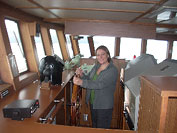

 | |||||||||||||||||||
|
|
Journals 2009/2010Jennifer Duncan
September 16, 2009 The sun was peaking its way out of the clouds as we were finishing up Prince William Sound stations PWS 2 and 3. We were surrounded by mountains filled with gigantic pine trees, gorgeous long waterfalls and several rainbows in sight. There were absolutely no houses, condos, roads, boats, or other people for that matter. As I looked around we were the only human beings in sight. That was OK by me. Over on Knight Islands (our next stations) there were two bald eagles just resting on top of a large tree branch. I can't believe how many bald eagles I have seen on this trip. Prince William Sound had small rocky shorelines with sea otters all around us, lying on their backs, chomping on their lunch. We also were on the lookout for bears on the coastline they are said to feeding on salmon here. However, we didn't see any. It was one of my favorite spots in the world. After a few loud splashes I saw a high spout coming over the starboard side of the boat. We eagerly ran over to observe while the Capt. made the announcement over the intercom. These divine black and white creatures, the killer whale (orcas) were definitely the rulers here. They traveled in pods of six or seven that I saw, and they were huge. One of the dorsal fins was so large I would bet it was 3-4 feet high. It was from a distance and it was also curved towards the water, nonetheless, it still looked huge. Although we tried to follow them a while, they were fast (about 25 mph) and had their own agenda, feeding. The fresh air was so crisp and the water were so promising I did not want to return to our destination, the Seward Line again. Hopefully, it will be calmer then it was. Surprisingly, as we were traveling out of the sound we saw humpback whales in the distance. Luckily, I was at the bridge when they appeared in the horizon. We didn't get to see them as close up as the killer whales, however their appearances was a special unexpected treat.
Most of the humpback whales are primarily from the Hawaiian stock. They travel great distances, over 2,800 miles (4,500 km) to feed on the flourishing plankton here in the sound. They are preparing if they haven't left already to head back to Hawaii. We were lucky to have seen them at this time of the year. We began heading back to the Seward Line to complete all the remaining stations out there. As we started the engines Toby Burke started heading back up to his spot, the bird watching station on board. Toby is a wildlife technician at Kenai National Wildlife Refuge. He completes wildlife and botanical surveys for them. He was the "bird expert" onboard.
He showed me my first puffin bird that I have ever seen. He explained that they actually molt their beak in the winter. We also got to see many rare albatross today. The huge flock of albatross thrive in-between stations GAK 9 and 10. I must have seen over 50 birds in one area. The continental shelf drops off into the deep water basin which creates upwelling. Upwelling brings up rich nutrients from the deep which nurture the phytoplankton, zooplankton, the small fish, and up the food chain to the birds. Questions: |
||||||||||||||||||



